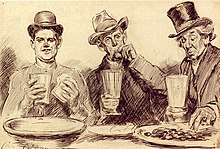
The New York State liquor tax law of 1896, also known as the Raines law, was authored by the New York State Senator John Raines and adopted in the New York State Legislature on March 23, 1896. It took effect on April 1, 1896, was amended in 1917 and repealed in 1923.
Among other provisions, the Raines law increased the cost of liquor licenses, raised the drinking age from sixteen to eighteen, and prohibited the sale of alcoholic beverages on Sundays except in hotels, as well as in lodging houses with at least 10 rooms that served drinks with complimentary meals.
Most men worked a six-day week, and Sunday was the only free day for recreation, so the new law was not very popular. Answering the demand, saloon owners quickly found a loophole by adding small slightly furnished rooms, complimentary food and applying for a hotel license since state statutes seemingly allowed that any business was considered a hotel if it had 10 rooms for lodging and served at least sandwiches with its liquor.
Raines sandwiches

The meal requirement was met by the cheapest sandwich available, sometimes reused across tables, or sandwiches made of rubber.
Jacob Riis wrote in 1902 of saloon keepers who mocked the law by setting out "brick sandwiches," two pieces of bread with a brick in between, thus fulfilling the legal requirement of serving food. He also writes of an altercation in a saloon where a customer attempted to eat a sandwich that the bartender had served just for show; "the police restored the sandwich to the bartender and made no arrests."
Raines law hotels
Scores of "Raines law hotels," often located directly above saloons, opened. A year later, there were 1,500 of them in New York; in Brooklyn the number of registered hotels went from 13 to 800 after six months.
As a contemporary source put it, "This offered a premium on the transformation of saloons into hotels with bedrooms and led to unlooked-for evils," an increase in prostitution, as the rooms in many "Raines law hotels" were used mostly by prostitutes and unmarried couples. In some cases these rooms may not even have been available at all; in a 1917 novel, Susan Lenox: Her Fall And Rise, the protagonist sees "a Raines Law hotel with awnings, indicating that it was not merely a blind to give a saloon a hotel license but was actually open for business."
To fight the Raines law hotels the so-called Committee of Fourteen was organized in 1905.
Consequences
It was nominally a liquor tax, but its intention was to curb the consumption of alcohol by imposing stricter regulations which it failed to do.
By 1911, the Committee had successfully lobbied for the shutdown of many of the Raines law hotels.
In popular culture
A shabby, Raines law hotel-type New York City saloon and rooming house serves as the 1912 setting of the classic play The Iceman Cometh, by Eugene O'Neill.
A bar named the Raines Law Room, at the Williams Hotel in New York City, is named in commemoration of the impact of the law.
See also
References
- "An act in relation to the traffic in liquors, and for the taxation and regulation of the same, and to provide for local option, constituting chapter twenty-nine of the general laws." Chapter 112 of the Laws of 1896, volume 1, pages 45–81, enacted 23 March 1896.
- J. Raines. The Raines Liquor-Tax Law, The North American Review, Vol. 162, No. 473 (Apr., 1896), pp. 481-485
- ^ Hartman, Darrell (2019-06-03). "To Evade Pre-Prohibition Drinking Laws, New Yorkers Created the World's Worst Sandwich". Atlas Obscura. Retrieved 2019-09-22.
- "Reprising Our Niederstein's Story, Now That It Is A Thing Of The Past". The Times Newsweekly (Ridgewood, NY). 2005-02-10. Archived from the original on 2006-06-25. Retrieved 2006-11-20.
- Riis, Jacob A. (1902). The Battle with the Slum. Macmillan., p. 224
- The Raines Law Hotel and the Social Evil, by Committee of Fifteen. New York, N.Y.: 1905
- Richardson, Dorothy (1905). The Long Day: The Story of a New York Working Girl. The Century Company., p. 33, "I made my first inventory of that block of Fourteenth Street where I lived. On each corner stood a gaudy saloon, surmounted by a Raines law hotel."
- Smith, Ray Burdick (1922). Political and Governmental History of the State of New York. Syracuse Press.p. 25
- ^ Suderman, Peter (2023-10-12). "The bad law that made good bars". Reason.com. Retrieved 2023-10-17.
- Phillip, David Graham (1917). Susan Lenox: Her Fall And Rise. New York: D. Appleton And Co., Project Gutenberg eText #450
- John P. Peters. Suppression of the "Raines Law Hotels", The Annals of the American Academy of Political and Social Science, Vol. 32, November 1908, p. 558
- Raines Law, St. Louis Public Library
- Andrew Whalen. Are 'Cuomo Chips' the New 'Raines Sandwich' for Bars Struggling to Survive?, Newsweek, July 23, 2020
Further reading
- John Raines. The Raines Liquor-Tax Law, The North American Review, Vol. 162, No. 473 (Apr., 1896), pp. 481-485.
- Frank B. Gilbert and Robert C. Cumming. The Liquor Tax Law of 1896: The Excise And Hotel Laws of the State of New York, As Amended to the Legislative Session of 1897. With Complete Notes, Annotations and Forms. Albany, N.Y.: M. Bender, 1896.